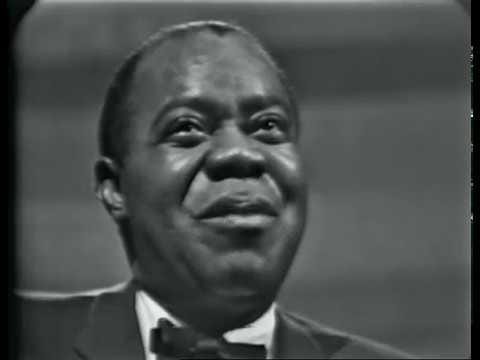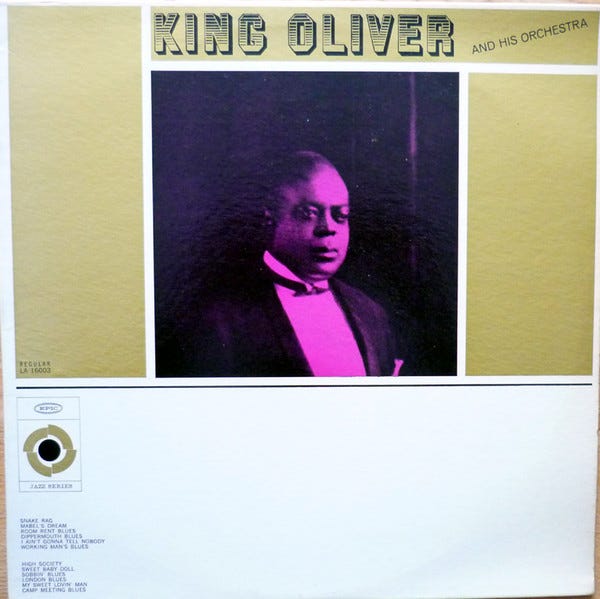This will be a series of posts about these classic recordings from 100 years ago!
Like many of you, I became fanatic about jazz (and other music) at an early age. Later, when I was 16, the late jazz critic John S Wilson published in the New York Times a list of essential jazz LPs. From then on, I took that with me whenever there was a storewide sale at Sam Goody’s record shop in mid-Manhattan. (Goody’s attempted to stock every LP in print.) It was an amazingly open-minded list, and I give Wilson a lot of credit, because he included everything from Armstrong’s Hot Fives and Sevens (Story), to B.B. King and John Lee Hooker, to the latest albums by John Coltrane (Kulu Sé Mama), Cecil Taylor (Unit Structures), and Albert Ayler (Bells)!!:
One of the albums listed was an LP on Epic records of some of King Oliver’s 1923 recordings:
(As you can see above, Wilson also listed an RCA LP that contained some late ‘20s Oliver recordings.)
I can't explain why, but these recordings immediately spoke to me. My peers and family thought I was nuts for enjoying what sounded to them like scratchy old sounds. But what I heard was a living, energized, hard-swinging group of musicians that interacted with each other wonderfully. In this series of posts, I’m hoping that I can help you to hear what I hear in these famous recordings. And for those of you who already know and love them, I believe that there will be a few observations that will be new to you. But first, let me give some background information:
Louis Armstrong (1901-1971) always acknowledged Joseph Nathan “King” Oliver (probably born 1881; died 1938) as his mentor. (Both birthdates involve long stories which I’ll explore with you later on.) Louis was with the band for about two years. He arrived in Chicago on Saturday July 8, 1922, around 11pm (he must have left New Orleans the day before, because the train ride is over 20 hours), and he left Oliver in late June 1924. After that he worked with other bands around Chicago, before moving to New York City to join Fletcher Henderson’s band around the very end of September.
The 37 sides (including more than one take of some tunes) made in 1923 were the recording debuts of Oliver, Armstrong, and everybody else in the band, except for clarinetist Buster Bailey, who had been recording with singer Mamie Smith and others since 1921. Oliver and company recorded for four different labels that year—Okeh, Columbia (which bought Okeh in 1926), and Paramount in Chicago, where the band was performing, and Gennett in Richmond, Indiana, over 250 miles south. (The best online resource for everything to do with Armstrong’s recordings is Michael Minn’s site, here.) Oliver went on to record with his later bands through 1931.
Most of the original 78 rpm record labels simply said “King Oliver’s Jazz Band,” but Gennett added the word “Creole.” In fact, Oliver had been using the word “Creole” in his band’s name at gigs as well, and sometimes “Original,” as you can see in this newspaper ad from Oakland, California in 1921, before Louis joined:
(Yes, the band traveled that far! They were in California from about June 1921 through April 1922, and they were not the only New Orleans musicians touring—Oliver performed there with Jelly Roll Morton as well during that time. About the “galaxy” of Black stars and entertainers—Oliver was not the only “live” act. And the “live” shows alternated with the silent movie, now lost, Roads Of Destiny. This kind of entertainment went on right through the 1940s, at least. I described one with Billie Holiday and Louis Armstrong in 1947 here.)
Bill Johnson, who played bass and banjo in the band, had previously led the pioneering Creole Band (sometimes called Original Creole Band), and in fact Oliver had first left New Orleans for Chicago to work in a band led by Johnson. So Bill probably brought that term to the Oliver band. Oliver, Armstrong and some of the other musicians were not technically “Creoles”—that is, they had no French ancestry. But in those days, especially for a group coming from New Orleans, “Creole” also signified “classy” and “sophisticated.” In other words, it was marketing of a sort, not intended to be a strictly accurate description of the personnel. “Original” was another marketing term.
The band has gone down in history as one of the all-time great jazz ensembles, and people who saw them in person, such as the young white musicians in Chicago, always raved about how great they sounded and how well they worked together. One of the famous stories about the group’s interactive style comes from Armstrong himself. He recounted that when they were on stage, leading up to a “break” for the two cornetists (where the rest of the band would stop playing), Oliver would indicate to him in advance what to play by silently fingering the trumpet’s valves, or by playing a hint of it just beforehand. Louis talked about that often—one occasion was his appearance in 1963 in the pubic television Jazz Casual series, hosted by the late jazz journalist Ralph Gleason. Armstrong describes it here at 10:30:
However, as my friend and former grad student David Sager of the Library of Congress has pointed out in his notes to the Oliver recordings (more on that below), this couldn’t have happened in every case. There wasn’t often time to make up the breaks in the middle of performing, and they probably had a repertory of such breaks to choose from. Regardless, there are some great examples of these two-cornet breaks in the recordings, as we’ll hear.
In 1923, recording technology was still “acoustical,” which means that the sound was captured by a horn (something like the famous Victor logo of the dog listening to “his master’s voice” played back through the horn). If the band had existed in 1925, when microphones were becoming standard, they would have been captured in much better fidelity. Yet, those cornet breaks and many other features of the band are indeed evident on the recording that we will listen to today, “I Ain't Gonna Tell Nobody.” It's not one of the most-discussed recordings of the band but I think it highlights many of the band’s virtues.
The composer of the song, listed on the label in parentheses (as is standard to this day), was Richard M. Jones:
Born in Donaldsonville, Louisiana in 1892, Jones began his music career in nearby New Orleans, where he and Oliver had even performed together. He moved to Chicago in 1918 or 1919 and soon became a significant presence on that music scene, as a composer, pianist, record producer and more, until his death there in 1945. His best known and most recorded song was “Trouble in Mind.” It appears that “I Ain’t Gonna Tell Nobody” was never published as printed sheet music, but David Sager of the Library of Congress confirms that the song was copyrighted, with a handwritten leadsheet.
In fact, Sager, who is a trombonist and an expert on early jazz, is partly responsible for the audio quality that we’re about to enjoy. He produced, with audio engineer Doug Benson, what many consider to be the best-sounding reissue of the 1923 Oliver sides, which comes with a substantial booklet essay by Sager. Today’s recording is taken from that release.
The band was initially a septet, but at this time a bass sax was added, making it an octet:
King Oliver, Louis Armstrong (cornets), Honoré Dutrey (trombone), Johnny Dodds (clarinet), Charlie Jackson (bass saxophone), Lil Armstrong (piano), Johnny St. Cyr (banjo), Baby Dodds (drums)
OK—so, here is “I Ain’t Gonna Tell Nobody,” recorded in Chicago, October 1923. Please listen just for pleasure now. In the next post, we’ll go back and check out numerous details, along with notated music, a rare photo, and more:
There’s much more to come about King Oliver!! In the meantime, be well!
All the best,
Lewis







I’m curious about this New Strand Theater in the ad, since that’s about half a mile from my house. No sign of a theater in that location these days.
Jones was also the composer of the blues standard "Trouble In Mind", and played piano on the first known recording of it.